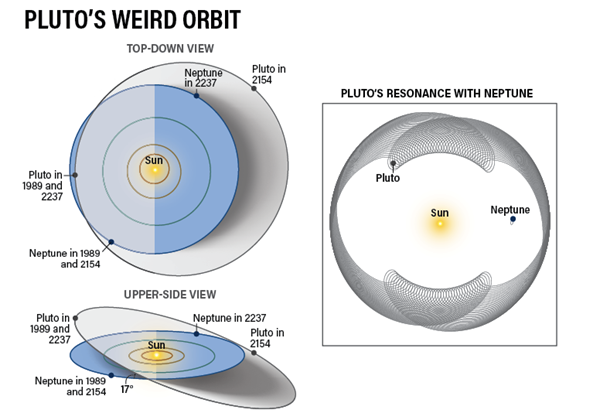Will Pluto and Neptune ever collide?
St. Louis, Missouri
With Pluto spending 20 years of its 248-year orbit within the orbit of Neptune, you might expect that at some point, the two worlds could catastrophically collide. However, Pluto and Neptune never actually pass through the same three-dimensional point in space because Pluto’s elliptical orbit is tilted 17° to the ecliptic. But what about in the future?
Pluto’s orbit experiences two effects that keep the dwarf planet safe: Its point of closest approach to the Sun oscillates in the vertical direction and also in the radial direction. These orbital effects are called latitudinal libration and azimuthal libration, respectively.
Latitudinal libration always puts Pluto high above Neptune’s orbit during their closest approach to each other. And azimuthal libration ensures Pluto never crosses Neptune’s orbit within 90° of the ice giant.
These properties are a consequence of a so-called orbital resonance between the two worlds. Pluto and Neptune are locked in a 3:2 orbital resonance, which means that for every three trips Neptune makes around the Sun, Pluto orbits twice. If they start getting out of sync, their mutual gravitational pull nudges them back into a finely choreographed dance. As a result, Pluto and Neptune never come within about 16 astronomical units (where 1 astronomical unit is the average Earth-Sun distance) of one another.
Despite this, in the late 1980s, numerical simulations suggested that Pluto’s orbit is technically chaotic: Over the course of several billion years, Pluto should either collide with another world or be ejected from the solar system entirely. However, in a recent paper titled “Pluto near the edge of chaos,” published March 31, 2022, in Proceedings of the National Academy of Sciences, researchers explored why Pluto’s orbit ultimately has remained stable over the solar system’s lifetime.
To do this, they ran a series of simulations of the outer solar system that tracked the evolution of Pluto’s orbit over about 4.5 billion years. The researchers found that, somewhat surprisingly, Uranus seems to push the dwarf planet toward a chaotic orbit. But while Neptune provided the greatest contribution to stabilizing Pluto’s azimuthal libration, the giant planet did not significantly influence the strength of Pluto’s latitudinal libration. Instead, Jupiter seemed most responsible for this particular collision-avoidance feature of Pluto’s orbit. So, as long as our solar system maintains the orbital status quo, we shouldn’t expect any planetary fireworks.
Digital Editor










